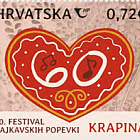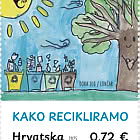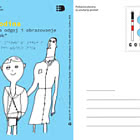Croatian Flora
BISTRICA
The Bistrica variety is a shrub rose of upright growth and golden-yellow flowers with a pleasant scent. It can be used as an ornament in the garden or as a cut flower because the cut flowers stay fresh in the water for a long time. Bistrica belongs to the so-called hybrid tea roses.
Hybrid tea roses are the largest and most widespread group of roses, popular due to the great variety of colors and shades of flowers and frequent flowering. They are also very popular as cut flowers since their stalks are strong, straight, long and erect and mostly bear a single, beautifully shaped flower. The size of the flower varies from 8 to as much as 18 cm in diameter. The flowers are characterized by a pleasant scent. The height of the shrub depends on the variety and varies from 40 to 150 cm. It is believed that the first hybrid tea rose was the La France variety, which was discovered by accident by gardener Pierre Giullot in 1867. It combines a number of desirable properties: repeat-flowering, elegant buds that open into large flowers and good resistance to frost. The development of this group was greatly contributed to by the Englishman Henry Bennett, who began with the systematic hybridization and selection of roses in 1879. Since then, the number of new varieties has grown rapidly and nowadays the majority of newly created varieties of roses comes from the group of tea roses.
The creator of the Bistrica variety is Josip Rogin (1947-2020), a writer, gardener and rose-enthusiast. Rogin has dedicated his entire life to roses, and during decades of rose hybridization and cultivation, following the example of the famous English rose breeder David Austin, he created a Croatian collection of roses with more than 20 new varieties. Some of them are grown in the Botanical Garden of the Faculty of Science of the University of Zagreb.
The Bistrica rose was bred from the Doris Tysterman variety, a tea rose with orange flowers combined with a yellow hue. The Bistrica variety was named after the shrine of Our Lady of Bistrica in Marija Bistrica, where in 1994 it was first promoted for the Feast of the Assumption.
CHRIST JUBILEE
The Christ Jubilee rose variety is a tea rose whose petals are delicately pinkish-yellow, with intense red dots. Due to its special flowers, the Christ Jubilee is a favorite garden rose, and can be found in many nurseries. The creator of this variety is also Josip Rogin.
Roses belong to the genus Rosa. The genus Rosa – depending on the author – includes 100 to 250 wild species of roses distributed mostly in the temperate zone of the northern hemisphere. More than 30 species of the genus Rosa grow wild in Croatia. Among the most common species in Croatia are the pomegranate (Punica granatum), the dog rose (Rosa canina), field rose (R. arvensis), rugosa rose (R. rugosa), Gallic rose (R. gallica), sweetbriar rose (R. rubiginosa), mountain rose (R. pendulina) and the evergreen rose (R. sempervirens).
Roses are best known as ornamental plants in gardens and parks and as cut flowers. However, except in horticulture, the application of roses can be very diverse. For instance, the fresh fruit of the Rosa caninaspecies, which is rich in vitamins, particularly vitamin C, is processed into jams and dried into teas or tea blends. The petals of some wild or cultivated roses can be used for food or as an addition to dishes. The essential oil obtained from rose petals is an important raw material in the perfume and cosmetics industry. Fragrant oils are most often commercially extracted from the Rosa damascena and the Rosa centifoliavarieties. The entire rose hip fruit is used for medicinal purposes, as well as the shells and seeds, mostly of the wild rose and mountain rose varieties. In aromatherapy, the scent of roses is used for therapeutic purposes due to its relaxing effect.
SLAVOLJUB PENKALA
The flowers of the Slavoljub Penkala rose variety are characterized by very diverse colors of their petals: from completely yellow, orange streaked with yellow stripes to completely yellow rose that are the color of old gold. The Slavoljub Penkala variety was created from the Ambassador variety, the most famous rose for cutting in yellow-orange color. Slavoljub Penkala is a tea rose that can be used as a cut flower or for cultivation in the garden, and its creator is Josip Rogin.
The rose (Rosa) is the eponymous genus from the rose family (Rosaceae). The rose family is a large group of very diverse, predominantly woody plants. Most of them are of great economic significance, with important edible, medicinal or ornamental species. The rose family includes most widespread fruit species, such as apples, plums, strawberries, raspberries, peaches, etc.
Roses are deciduous, rarely evergreen shrubs with thorny stems that are erect or climbing. Although roses are commonly said to have thorns, these are actually prickles. Unlike real thorns, prickles are relatively easy to break off and separate from stems. The leaves of the roses come in oddly numbered pinnates and have stipules. The five-petaled flowers contain numerous stamens. The fruits are popularly known as the hip, the hep or the haw.
Due to the beauty and scent of the flowers, roses have long been grown as horticultural plants and it is estimated that today there are about 30 thousand varieties in cultivation. The Slavoljub Penkala variety was named after Eduard Slavoljub Penkala, a Croatian inventor of Polish origin. Although Slavoljub Penkala's body of work includes about 80 inventions, probably his most famous inventions are mechanical pens and fountain pens with solid ink, the forerunner of the ballpoint pen.
Prof. Mihaela Britvec, PhD
Faculty of Agriculture, Zagreb
Croatia - Recommended stamp issues
WOPA+ recommended stamp issues
| Avatar - Fire and Ash |
| Issued: 03.12.2025 |
| ›New Zealand |
| 50th Anniversary of the Founding of the 24th November Bar Scout |
| Issued: 24.11.2025 |
| ›Montenegro |
| Krisjanis Valdemars |
| Issued: 02.12.2025 |
| ›Latvia |
| Sign Language - Good |
| Issued: 02.12.2025 |
| ›Bosnia and Herzegovina - Republic of Srpska |
| In Memory of the Fallen and Murdered on October 7, 2023 |
| Issued: 08.10.2025 |
| ›Israel |
| Annual Collection Folder (New York) |
| Issued: 05.12.2025 |
| ›United Nations |
| Year Set |
| Issued: 24.11.2025 |
| ›Isle of Man |
| Shipping in the 17th and 18th Centuries - Peat Shipping |
| Issued: 05.12.2025 |
| ›Netherlands |














































